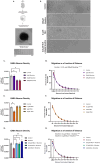Nicotine in e-cigarette aerosol reduces GABA neuron migration via the α7 nicotinic acetylcholine receptor
- PMID: 41083506
- PMCID: PMC12518607
- DOI: 10.1038/s41598-025-19504-7
Nicotine in e-cigarette aerosol reduces GABA neuron migration via the α7 nicotinic acetylcholine receptor
Abstract
Prenatal nicotine exposure is linked to adverse neurodevelopmental outcomes, yet e-cigarette use during pregnancy continues to rise due to aggressive marketing efforts and misconceptions of safety. We investigated the effect of prenatal e-cigarette aerosol exposure on the migration of GABA neurons, a developmental process critical for the establishment of cerebral cortical circuitry. Pregnant mice were exposed to nicotine-containing aerosol (e-cigarette), nicotine-free aerosol (e-liquid) or room air (control) daily beginning 2 weeks before conception and continuing until gestational day 14. E-cigarette, but not e-liquid, aerosol significantly reduced GABA neuron density in the dorsal cerebral wall at rostral forebrain level and within the marginal zone, reflecting region-specific vulnerabilities. In vitro explant cultures revealed that nicotine dose-dependently reduced neuronal migration, and this effect was mimicked by a selective α7 nicotinic acetylcholine receptor (nAChR) agonist. Blocking the α7 nAChR using a selective antagonist attenuated the effects of nicotine on neuronal migration. These findings reveal a previously unrecognized vulnerability of GABA neuron migration to e-cigarette aerosol and identify α7 nAChR activation as a mechanism for nicotine-induced impairment of GABA neuron migration. Moreover, the findings highlight the need for translational efforts to update clinical guidance and public policy regarding e-cigarette use during pregnancy.
Keywords: Brain development; E-liquid; GAD67-GFP; Ganglionic eminence; Interneuron; Prenatal nicotine.
© 2025. The Author(s).
Conflict of interest statement
Declarations. Competing interests: The authors declare no competing interests.
Figures



References
-
- Nickels, A. S., Warner, D. O., Jenkins, S. M., Tilburt, J. & Hays, J. T. Beliefs, Practices, and self-efficacy of us physicians regarding smoking cessation and electronic cigarettes: A national survey. Nicotine. Tob. Res.19, 197–207. 10.1093/ntr/ntw194 (2017). - PubMed
-
- Farsalinos, K. E., Romagna, G., Tsiapras, D., Kyrzopoulos, S. & Voudris, V. Characteristics, perceived side effects and benefits of electronic cigarette use: a worldwide survey of more than 19,000 consumers. Int. J. Environ. Res. Public. Health11, 4356–4373. 10.3390/ijerph110404356 (2014). - PMC - PubMed
-
- Bhandari, N. R. et al. Use and risk perception of electronic nicotine delivery systems and tobacco in pregnancy. Womens Health Issues28, 251–257. 10.1016/j.whi.2018.02.005 (2018). - PubMed
MeSH terms
Substances
Grants and funding
- 24KO7/The Florida Department of Health James and Esther King Biomedical Science Research Program
- 24KO7/The Florida Department of Health James and Esther King Biomedical Science Research Program
- 046803/The Council on Research and Creativity at Florida State University
- 046803/The Council on Research and Creativity at Florida State University
- F00662/The Jim and Betty Ann Rodgers Chair Fund
LinkOut - more resources
Full Text Sources
Medical

